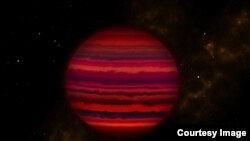Astronomers say they’ve collected evidence that points to the existence of the first water, or water ice, clouds detected outside the solar system.
Writing in the Astrophysical Journal Letters, scientists from the University of California Santa Cruz say the brown dwarf called WISE 0855, which is a mere 7.2 light-years from Earth, likely has the clouds in its atmosphere.
Using the Gemini North telescope in Hawaii, researchers scanned WISE 0855, the coldest known object outside the solar system, in the infrared spectrum, which yielded “the first details of the object's composition and chemistry.”
"We would expect an object that cold to have water clouds, and this is the best evidence that it does," said Andrew Skemer, assistant professor of astronomy and astrophysics at UC Santa Cruz and first author of the study.
Brown dwarfs are often referred to as failed stars, because they never gained quite enough mass to cause the nuclear fusion reactions that make them shine. WISE 0855 is about five times the mass of the gas giant Jupiter.
"WISE 0855 is our first opportunity to study an extrasolar planetary-mass object that is nearly as cold as our own gas giants," Skemer said.
Because WISE 0855 is so faint, researchers had to look at “thermal emission from the deep atmosphere at wavelengths in a narrow window” to gain insight into the composition of its atmosphere.
"It's five times fainter than any other object detected with ground-based spectroscopy at this wavelength," Skemer said. "Now that we have a spectrum, we can really start thinking about what's going on in this object. Our spectrum shows that WISE 0855 is dominated by water vapor and clouds, with an overall appearance that is strikingly similar to Jupiter."
The two bodies, researchers say, have “strikingly similar” spectra “with respect to water absorption” but that WISE 0855 likely has a less turbulent atmosphere than Jupiter.










